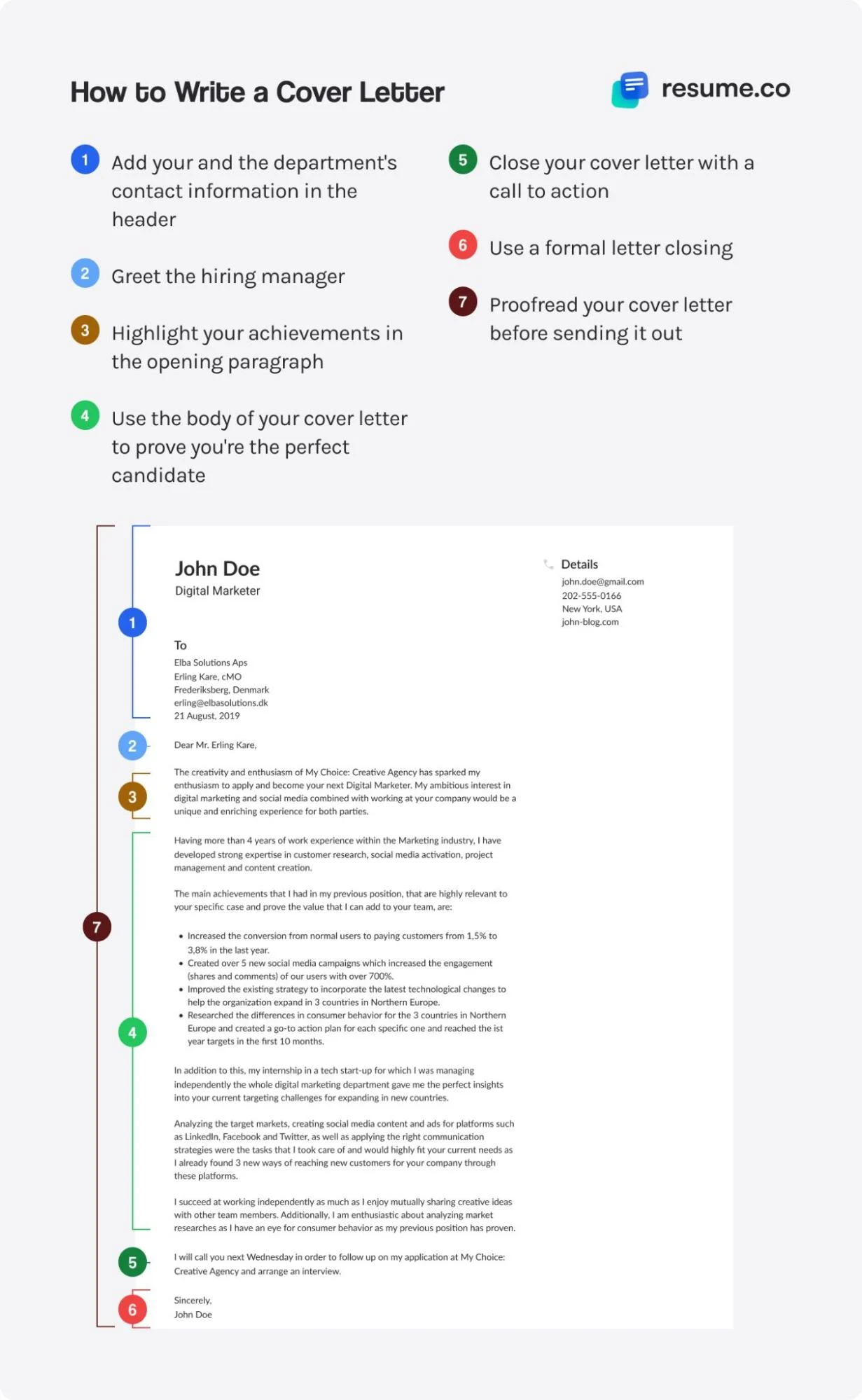As an architect, you’re used to juggling massive blueprints, polishing 3D models, and dealing with accidental coffee spills. You also know how to handle mountains of all kinds of documents, so writing an architecture cover letter shouldn’t be too difficult.
Crafting an attention-grabbing cover letter requires precision and finesse, much like trying to strategically position windows to capture the perfect view. It’s a document where structure meets eloquence and creativity mixes with professionalism. And, logically, a well-written architecture cover letter can also be the foundation for your career’s progress.
That’s why we’ve created this comprehensive guide that will teach you all you need to know about cover letters. You’ll learn everything from general rules to professional tips and tricks. Let’s get started!
Key Takeaways
Your architecture cover letter should be one page long, with 3–5 paragraphs and a clean, professional layout.
You’ll get bonus points with the hiring manager by addressing them by their name.
Use the first paragraph to grab the reader’s attention and the last one to add a call to action.
You should always write a new cover letter when applying for a new position. It should be tailored to the job ad while matching your resume.
How to Format an Architecture Cover Letter
A good thing about cover letters is that there’s an established format to follow while writing them. This format stays the same for all candidates, whether you’re writing an architectural designer cover letter or a cover letter for a BIM architect. It goes like this:
Architecture Cover Letter Format Guidelines
Your and the recipient’s contact information, along with the date of writing
A cordial greeting (e.g., Dear Mr. Smith)
A strong introductory paragraph that should grab the reader’s attention
1–3 paragraphs that talk about your architect skills and accomplishments, describing what makes you the perfect candidate for the role
A closing paragraph with an impactful call to action
A cordial closing (e.g., Best regards)
Your full name
(Optional) An attention-grabbing postscript with a notable achievement that might convince hiring managers who skimmed your letter to potentially go back and read it thoroughly
By following this structure while writing your architecture cover letter, you’ll end up with a concise document packed with valuable information. You’ll show hiring managers everything they want to see in the most effective order.
Now, let’s see how you can make your document visually captivating by utilizing a professional cover letter layout:
Cover Letter Layout
Your cover letter should be one page long.
It should have between 3 and 5 paragraphs or 250–400 words.
You want a clean, cover letter-friendly font (e.g., Arial, Calibri, or Helvetica).
The font size should be 10–12 pt.
Set margins to one inch and include proportional white space between sections and paragraphs.
How to Write an Architecture Cover Letter

Now that you know the general guidelines regarding the format and layout of your architecture cover letter, you might be tempted to start drafting. However, if you stick around for a few moments longer, you’ll learn how to get every section of your document right, down to the sign-off.
To help you visualize this guide, here’s a graphic depiction of a cover letter template:

#1. Add Contact Information in the Header
The contact information section is one of the easiest to write. There’s no need to get creative. You should simply include the following details in your cover letter header:
Mandatory Details
Your name
Job title
Phone number
Email address
Mailing address (optional)
After your details, you should include the date of writing before adding the recipient’s information. It’s vital to try to find their real name to include both here and in the cordial greeting. People are much more likely to respond to their names, making this a great way to stand out in the crowd of candidates.
Now let’s check out an example of a contact information section:
Good Example
Phyllis Garcia
Architect
3775 Irving Road
Gallipolis, OH 45631
619-434-2569
phyllis.garcia@example.com
San Diego, 21/06/2023
Amy Dixon
Hiring Manager
Tall Tower Architecture
1940 Ashcraft Court
San Diego, CA 92105
#2. Greet the Hiring Manager
Here’s a simple yet strong way to greet the hiring manager:
Good Example
Dear Ms. Dixon
As you can see, there’s no need to overcomplicate it. The important thing is to mention their name, which you hopefully found while researching the company. If you didn’t manage to do that, you can swap the recipient’s name for their title. What you should avoid is the generic “To whom it may concern,” as it feels too distant and impersonal.
#3. Emphasize Your Achievements in the Introduction
The first paragraph of your architecture cover letter is often the most important. That’s because many hiring managers have lots of cover letters to go through. As a result, they leaf through them until one grabs their attention.
You want to be the one that stops hiring managers in their tracks and convinces them to give your cover letter their full attention. To achieve that, start your cover letter with a couple of your most impressive accomplishments. Give them a taste of your capabilities, and they’ll keep reading to find out more about you.
Let’s see that in an example:
Good Example
I am excited to apply for the position of senior architect at Tall Tower Architecture. With more than 13 years of experience in the field and 167 blueprints designed for corporate clients, I am confident that my expertise and passion make me an ideal candidate for this job.
#4. Elaborate on Why You’re the Right Fit
One of the biggest reasons for writing a cover letter is to show that you’re the right person for the specific job. Architecture is a vast field, so whether you’re creating a junior architect cover letter, an architecture cover letter for an internship, or that for a senior position, you’ll need to highlight different sets of skills and experiences.
As a result, most of your writing should involve those abilities and competencies that will help you perform the role that you’re applying for.
Here’s a good example:
Good Example
My skills allowed me to lead a multidisciplinary team in designing and constructing a 250-room East View Hotel in the Bay Area. Furthermore, I evaluated the costs of 40+ projects and negotiated contracts with 200+ clients, which resulted in a 27% increase in the company’s profits.
For bonus points, you can explain how the company that you’re interested in is a good fit for you too. To achieve that, you can mention something about them that truly resonates with you, such as their goals and aspirations, work ethic, or similar.
Let’s see that in an example:
Good Example
I have been following the work of Tall Tower Architecture for years, and your commitment to sustainability resonates with me. Therefore, I believe my experience working on large-scale residential complexes and urban planning projects, along with a deep understanding of codes, regulations, and sustainability principles, can have a significant impact on your projects.
#5. Add a Call to Action
So, you’ve written an architecture cover letter with a strong introduction and a compelling midsection. How do you capitalize on that with a powerful finish? The answer is simple: end your cover letter with a call to action in the last paragraph.
Here’s how you can do that:
Good Example
Thank you for considering my application. I have attached my resume and portfolio, which provide further details about my qualifications, for your review. I would welcome the opportunity to discuss how I can contribute to the success of Tall Tower Architecture.
#6. Write a Formal Closing
After finishing the body of your architecture cover letter, it’s time to close it just the way you opened it—briefly and formally. There are several ways to do that, including:
Cover Letter Formal Closing
Sincerely
Best regards
Kind regards
With appreciation
Thank you for your time
After that, add your name, and you’re done. Here’s an example:
Good Example
Sincerely,
Phyllis Garcia
#7. Proofread the Cover Letter
The final step in the writing process involves proofreading. This allows you to spot and correct any potential mistakes you could’ve made. Moreover, by proofreading a cover letter, you can ensure you’ve included all the important details that can help your application.
Furthermore, proofreading a cover letter can help you better tailor it to the job ad. Lastly, it’s a great way to check whether you’ve merely repeated the content of your architect resume or actually added new, valuable information.
Let’s check out a complete example of a senior architect cover letter.
Architecture Cover Letter Writing Tips
Before we wrap things up, we’ve prepared a couple of expert tips that will help you polish your architecture cover letter:
The design of your architecture cover letter should be clean, formal, and professional. The focus of the document should be on writing, but you should refrain from getting too creative with your cover letter and highlight your artistry through your portfolio instead.
When submitting a soft copy of your cover letter, you should make all links in the contact information section clickable. That shows attention to detail on your end and incentives hiring managers to click on them, increasing the chances of your website, portfolio, or social media profile being seen. The longer they spend examining your application, the higher the chances that they will call you for an interview are.
Even though there are precise guidelines regarding the format and layout of your architecture cover letter, you should write a new one for each new job that you’re applying for. The last thing hiring managers want to read is a bland and generic cover letter that shows you barely put any effort into it.
A simple “black text on white background” cover letter is much better than an overly designed one with unnecessary colors and graphics. You should keep your artistic tendencies in check and stick with the basics unless you really know what you’re doing.
Consider sending a sample PDF of your architect cover letter to a friend or colleague for review. They can help you proofread it, spot areas for improvement, or notice mistakes you might’ve overlooked.
Closing Thoughts
And that’s all there is to it!
Wielding the tools of professionalism and creativity, coupled with a bit of guidance sprinkled throughout this article, you’ll be able to write an outstanding architecture cover letter.
Remember not to treat this document as just another piece of paper. Instead, think of it as a portal into your personal architectural world. Use it to showcase what makes you good at what you do and highlight your unique blend of prowess and artistry.
To further prepare, consider reviewing common architect interview questions to ensure you're ready for the next step.
The rest is up to you. Sharpen your pencils, dust off your keyboards, and write with flair and precision—the job of your dreams might be one cover letter away.
Related Articles
Interior Designer Cover Letter & Writing Guide


